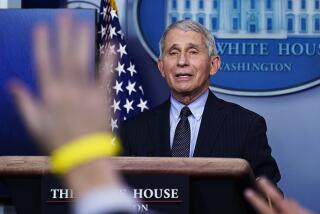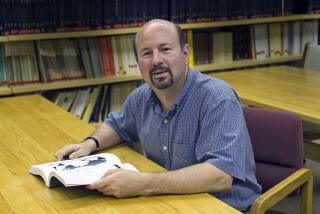Court Case Details Tobacco Firm’s Use of German Lab
- Share via
Internal Philip Morris documents made public Tuesday shed new light on a little-known German laboratory that the company has used for years to perform sensitive research in a locale seemingly beyond the reach of critics in the United States.
The documents, filed in a Minnesota lawsuit against several major tobacco companies, also include memos suggesting that Philip Morris officials were willing to destroy or suppress research on nicotine’s addictive properties.
Tuesday’s filing was an attempt to force Philip Morris and other cigarette companies to provide a more detailed response to allegations of document destruction. A central contention in the lawsuits filed by Minnesota and 15 other states is that tobacco companies willfully hid information on the health hazards of smoking.
One Philip Morris memo made public Tuesday refers to the German lab as “a locale where we might do some of the things which we are reluctant to do in this country.” That statement was part of a memo written in April 1970 by Helmut Wakeham, the company’s vice president of research and development, urging that Philip Morris buy the facility. The lab, called INBIFO, was purchased in 1971 by Philip Morris’ Swiss subsidiary, Fabrique Tabac Reunies (FTR). INBIFO is a German acronym for Institute for Biological Research.
Lawyers suing the tobacco companies have said for months that they were very interested in INBIFO. Last January, after the plaintiffs in a class-action case in New Orleans asked a judge for permission to conduct legal discovery about the facility, Philip Morris sent a letter to the judge saying that INBIFO had been conducting research into “nicotine addiction/habituation/dependence.”
In the other documents released Tuesday, some Philip Morris officials seem to suggest that damaging findings on those subjects be suppressed.
However, Philip Morris lawyer Michael York took issue with the plaintiffs’ allegations that Philip Morris appears to have a “pervasive philosophy” of suppressing or destroying unfavorable research.
“That is absolutely untrue,” York said. “There is no such philosophy by the company; there never has been. We’ve been served with massive requests for production of documents. We are working literally night and day to comply with the production schedule. We’ve produced millions of pages of documents, including these documents which the plaintiffs say provide the foundation for this unfounded allegation. That kind of allegation is designed, at least in part, to try to influence judges and juries.”
He added: “Obviously we take this very, very seriously. We’re going to respond to this motion in detail, in full, in court.”
The company will have its chance Oct. 8, when plaintiffs will try to persuade a judge to order Philip Morris and other tobacco firms to turn over more documents like those unveiled Tuesday.
Those include a November 1977 memo by a Philip Morris scientist who wrote to the company’s director of research and said that if studies on nicotine’s addictive properties turned out unfavorably, “We will want to bury it.”
“Accordingly, there are only two copies of this memo, the one attached and the original, which I have,” scientist William Dunn wrote to research director Thomas S. Osdene.
Another document is an undated, unsigned, handwritten memo from Osdene’s files that Philip Morris turned over to Minnesota lawyers. The note includes the direction that “if important letters or documents have to be sent, please send them to home, where I will act on them and destroy.” The document “appears to be” in Osdene’s handwriting, according to the brief filed by lawyers working for the Minnesota attorney general.
All the memos made public Tuesday are part of Minnesota’s effort to compel Philip Morris and other defendants in the massive lawsuit to respond to written questions relating to alleged document destruction. Minnesota has sued all the major tobacco companies seeking reimbursement for the cost of treating indigents who suffer smoking-related illnesses.
Corey L. Gordon, one of the attorneys working for Minnesota, said that discovery in the case revealed “a disturbing number of instances of the destruction--or potential destruction--of relevant documents.”
Gordon also asserted that “mounting evidence points to a pattern by certain defendants--including Philip Morris Inc.--of purposefully using third parties to maintain their documents, apparently to preclude discovery” by people suing the companies.
In particular, Gordon said that Philip Morris “has long viewed INBIFO as a good place to conduct potentially damaging research, perhaps beyond the purview of discovery.”
In support of this contention, Gordon lodged a 1977 memo written by Philip Morris Vice President Robert Seligman, who emphasized to a colleague that the company had taken “great pains to eliminate any written contact” between the cigarette manufacturer and the lab. Seligman suggested that some test samples be sent to a “dummy” mailing address in Cologne, Germany, and that written reports from INBIFO be routed to FTR in Switzerland in order to avoid direct contact between INBIFO and Philip Morris USA.
The same year, Dunn wrote his memo to Osdene about a proposed study of the addictive properties of nicotine. “If [the researcher] is able to demonstrate, as she anticipates, no withdrawal effects of nicotine, we will want to pursue this avenue with some vigor. If, however, the results with nicotine are similar to those gotten with morphine and caffeine, we will want to bury it.”
Veteran industry critics such as Chicago lawyer Cliff Douglas, who wrote a memo for the White House on INBIFO last year, said the newly released documents lend support to the contentions of Ian Uydess, a former Philip Morris scientist who told the Food and Drug Administration in March that the company had used INBIFO to conduct secret research abroad in hopes of keeping it out of the hands of anti-smoking forces in the United States.
Uydess said that in the early 1980s Osdene had suggested to him that some nicotine studies Uydess had proposed “could be conducted in Germany at INBIFO if they proved to be ‘too sensitive’ to conduct in Richmond,” where Uydess was working.
“This option was apparently brought up in light of the company’s awareness and growing concern over the increased scrutiny of the tobacco industry by the government (FDA) and public regarding smoking and health issues,” Uydess said in a sworn affidavit.
Uydess also said that the research of another Philip Morris scientist, Frank Gullotta, on nicotine’s effect on the brain, “was ultimately shut down in Richmond and moved to a lab in Germany [at INBIFO] presumably because of the sensitive nature of the results that had been obtained.”
Uydess did not offer documents to support this charge. He said in a telephone interview Tuesday that he had seen INBIFO documents but had not kept any. “I wasn’t a document collector,” he said.
In March, responding to Uydess’ affidavit, Philip Morris said that INBIFO employed 149 scientists who it said were experts in “a wide array of disciplines, including engineering, physics, analytical chemistry, risk assessment, molecular biology, pharmacology and toxicology.”
More to Read
Sign up for Essential California
The most important California stories and recommendations in your inbox every morning.
You may occasionally receive promotional content from the Los Angeles Times.













